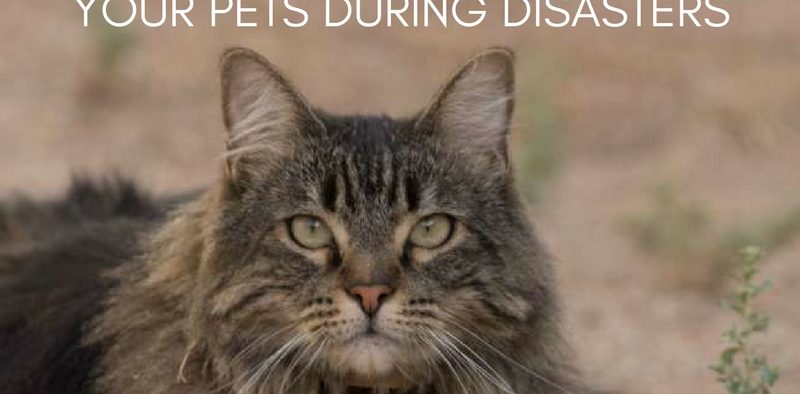PETS Act of 2006: Understanding your pets rights in a disaster
Share

The PETS Act of 2006 was passed to help improve disaster preparedness for pets, and for owners evacuating with their pets.
This Act is a good start in that it helps to ensure people can take their pets along with them during an emergency evacuation.
But, its effectiveness relies largely on your state and their willingness to make accommodations for pets. It’s really not as inclusive as we’d like to see it be.
For instance, private and public shelters can still deny your pets entry. Hotels can still deny entry.
In fact, all that the Act really accomplish was to give states incentive (in the form of funding) to accommodate pets.
This means, FEMA or the State may choose to build extra pet-friendly shelters. It also requires both agencies to include pets in emergency planning. For example, in federal evacuation on buses, pets should now be allowed. There are a few things they should do if they choose, and if they do, they can apply for DHS funds. If they don’t, no funding.
What is the PETS Act and How Does it Work?
After Hurricane Katrina devastated Louisiana and became the costliest (and largest screw-up in disaster management for both animals and people), the White House called for an evaluation of all actions taken.
This included a review of lessons learned by DHS and suggestions on how they can reduce the loss of life (both pets and people) during times of disaster.
In that assessment, it was recommended that DHS require State and local governments develop, implement, and exercise emergency response plans that were to be integrated with all Federal evacuation activities, before State and local governments are able to receive DHS-funded grants.
This act was created as a direct response to the horrific number of animals left behind during Hurricane Katrina as evacuation did not allow pets on buses, in shelters, or provide any assistance during this storm. Congress passed H.R. 3858, the Pets Evacuation and Transportation Standards Act of 2006 (PETS Act) in late 2006.
What does the PETS Act require?
The Department of Homeland Security (DHS) now requires State and local governments to develop, implement, and exercise emergency response plans and to be integrated into all federal evacuation activities, before state and local governments are able to receive DHS-funded grants.
Recently, there’s been a post going around on Facebook that says the following:
ATTENTION: If you are evacuating to a hotel/motel and they say they DON’T accept pets, don’t get ugly, but simply tell them that is against the law & FEMA established that after Hurricane Katrina! The Pets Evacuation and Transportation Standards Act (PETS) was a bipartisan initiative in the United States House of Representatives to require states seeking Federal Emergency Management Agency (FEMA) assistance to accommodate pets and service animals in their plans for evacuating residents facing disasters.
I’m sad to report that this is not true. It is not illegal for hotels to turn guests with pets away during a disaster, nor is it illegal for public or private shelters to do so (although we do consider it to be a completely immoral thing for any business to do).
All that the PETS Act accomplished was to provide more funding for states to create more pet-friendly shelters and gives more compensation for evacuation. But it doesn’t require privately owned properties (like hotels) to waive their pet policy.
Most properties (at least the reputable ones) suspend their “no pets” policies during times of disaster, but they aren’t required to do so by law.
On a side note, it’s being reported that the governor of Florida recently told hotels they need to waive their pet policies during Hurricane Irma, but I have yet to see anything officially released on this topic, so don’t count on it yet.
[load_module id=”210″]Before you finish your research, be sure to check out our article on “Evacuating with Pets & Livestock”
What the PETS act does say about pets in hotels and shelters?
The PETS Act divides shelters into 3 categories: Congregate, Transitional, and Animal Shelters
Congregate Shelter
Any private or public facility that provides contingency congregate refuge to evacuees, but that day-to-day serves a non-refuge function. Examples include schools, stadiums, and churches.
Transitional Shelter
Any private or public facility that, by design, provides a short term lodging function and an increased degree of privacy over a congregate shelter. Examples include hotels, motels, and cruise/berthing ships.
Animal Shelters
Generally, congregate sheltering facilities do not allow household pets (except service animals assisting people with disabilities), due to health and safety regulations. Eligible animal shelter costs include costs associated with the provisions of rescue, shelter, care, and essential needs (e.g., inoculations) for evacuee and rescued household pets and service animals, to include veterinary staff for emergency and immediate life-stabilizing care. Exhibition or livestock animals are not eligible for animal sheltering
Immediately after Hurricane Katrina devastated the Fifth district of Louisiana and became the costliest (and the biggest screw up in disaster management), The White House called for an evaluation of all actions taken. This summary included a review of lessons learned by DHS and suggestions on how they can reduce the loss of life (both pets and people) during times of disaster.
In that assessment, it was recommended that DHS require State and local governments develop, implement, and exercise emergency response plans. These plans were to be integrated with all Federal evacuation activities, before State and local governments are able to receive DHS-funded grants.
[load_module id=”593″]As a result, FEMA developed a disaster assistance policy titled “Eligible Costs Related to Pet Evacuations and Sheltering,” (DAP 9523.19) which provides specific guidelines on expenses that are (or are not) reimbursable to states. The statement also includes how they expend utilize federal and local resources before, during and after events.
In particular, the following items, for which a state could be reimbursed, are enumerated in FEMA’s policy (the following summary is borrowed this summary from the AVMA – please see their article for more information):
- Definition of what a “household animal” is
- Definition of what a “service animal” is
- Type of shelter employed
- What employees are utilized in rescuing animals
- Facilities, supplies, commodities, and labor used in sheltering operations
- Type of emergency veterinary services provided
- Type of transportation utilized in rescue
- Needs for safety and security of the shelter
- Cleaning and maintenance of the shelter
- Services for removal of dead animals
- Cataloging and tracking systems used for pets
- Timeframe under which the shelter may operate
Specific challenges that continue to be addressed include the following:
- Receipt retention for reimbursement
- Need for federal identification numbers and/or proof of nonprofit status
- Utilizing vehicles that fit the DAP 9523.19 requirements (ie., non-personal)
- Need for federal declaration, which may not be in place during the early days of a disaster
- Recognition that states typically are reimbursed for 75% of their expenditures during a federally-declared emergency (including state usage of volunteer hours as ‘in-kind’ services to meet the state’s 25%)
- Meeting the minimum $1000 per worksheet of expenditures for reimbursement to be considered
Additional Reading
If you get bored during the storm and you’re looking for some reading, we recommend these resources:
- National Animal Disaster Preparedness Day
- The Federal Response to Hurricane Katrina: Lessons Learned, The White House
- The entire PETS Act of 2006
- The entire DAP 9523.19 can be found at FEMA’s policy website: (the interesting hotel part starts at page 109.)
- Read Ed Kostro’s summary of his experience as a “boots on the ground” animal rescuer during Katrina in: Hurricane Katrina – My Journey Back in Time, and his follow up of lessons learned in Hurricane Katrina: 10 Years Later.
- Preparing Your Pets for Disasters: The Bug-Out Bag










